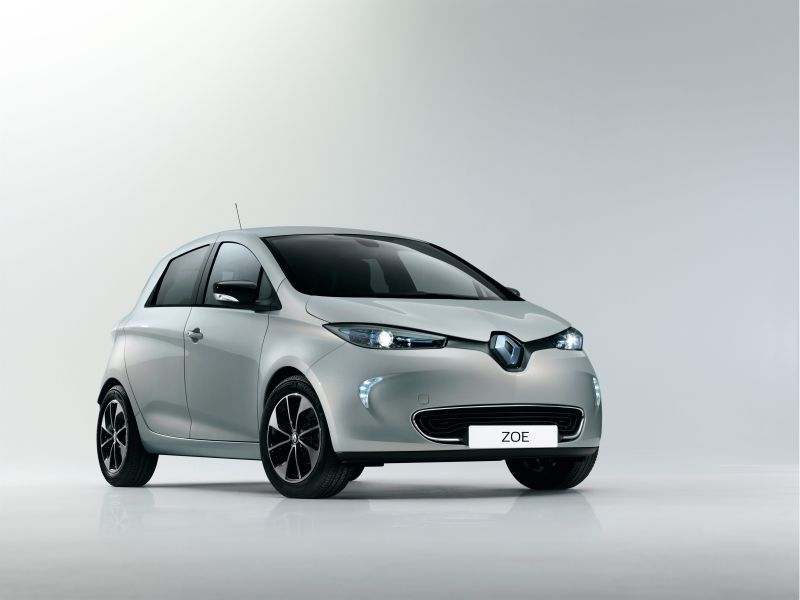2017 Renault Zoe I R75 44.1 kWh (77 Hp) | Specifications
























































| Body type | Hatchback |
| Brand | Renault |
| Doors | 5 |
| End of production | 2019 year |
| Generation | Zoe I |
| Model | Zoe |
| Modification (Engine) | R75 44.1 kWh (77 Hp) |
| Powertrain Architecture | BEV (Electric Vehicle) |
| Seats | 5 |
| Start of production | 2017 year |
Dimensions
| Front overhang | 839 mm |
| Front track | 1511 mm |
| Height | 1562 mm |
| Length | 4084 mm |
| Minimum turning circle (turning diameter) | 10.56 m |
| Rear (Back) track | 1587 mm |
| Rear overhang | 657 mm |
| Ride height (ground clearance) | 120 mm |
| Wheelbase | 2588 mm |
| Width | 1730 mm |
| Width including mirrors | 1945 mm |
Drivetrain, brakes and suspension specs
| Assisting systems | ABS (Anti-lock braking system) |
| Drive wheel | Front wheel drive |
| Drivetrain Architecture | One electric motor drives the front wheels. |
| Front brakes | Ventilated discs, 258 mm |
| Front suspension | Independent type McPherson, Transverse stabilizer |
| Number of gears and type of gearbox | 1 gears, automatic transmission |
| Power steering | Electric Steering |
| Rear brakes | Drum, 228.6 mm |
| Rear suspension | Transverse stabilizer, Torsion |
| Steering type | Steering rack and pinion |
| Tires size | 185/65 R15; 195/55 R16 |
| Wheel rims size | 6J x 15; 6.5J x 16 |
Performance specs
| Acceleration 0 - 100 km/h | 15.5 sec |
| Acceleration 0 - 60 mph | 14.7 sec |
| Acceleration 0 - 62 mph | 15.5 sec |
| Fuel Type | Electricity |
| Maximum speed | 135 km/h |
| Weight-to-power ratio | 19.2 kg/Hp, 52 Hp/tonne |
| Weight-to-torque ratio | 7 kg/Nm, 141.9 Nm/tonne |
Electric cars and hybrids specs
| All-electric range | 367-403 km |
| Average Energy consumption | 13.3 kWh/100 km |
| Battery location | Below the floor |
| Battery technology | Lithium-ion (Li-Ion) |
| Battery voltage | 400 V |
| Battery weight | 305 kg |
| Gross battery capacity | 44.1 kWh |
| Net (usable) battery capacity | 41 kWh |
Electric motor location Front axle, Transverse
| System power | 77 Hp @ 2600-9000 rpm. |
| System torque | 210 Nm @ 210-2600 rpm. |
Space, Volume and weights
| Kerb Weight | 1480 kg |
| Max load | 486 kg |
| Max. weight | 1966 kg |
| Trunk (boot) space - maximum | 1225 l |
| Trunk (boot) space - minimum | 338 l |
Frequently Asked Questions
Here are answers to some common questions
The VIN number, also known as the VIN code, is the vehicle identification number. VIN is an abbreviation of the English term Vehicle Identification Number. The VIN number is a unique set of 17 characters that car manufacturers assign to all vehicles they produce. The VIN code can be found on various parts of the car body or in the registration documents.
In the CarVertical vehicle report, you will find the most important information about the vehicle that will allow you to assess the condition of the vehicle. In the report, you will find information such as vehicle mileage, accident data, countries of previous registrations, records from searched car databases, and much more useful information.
CarVertical reports are available immediately or can take up to a few minutes. The service is provided 24 hours a day, 7 days a week, reports are generated automatically. It basically takes as long as it takes to process your payment - the sooner the money reaches your CarVertical account, the sooner you will receive a report.
First of all, CarVertical is generally the world's first provider of VIN history reports by car code, receiving some of the data in real-time directly from the car. The information obtained in this way is the most up-to-date, which is why it is so operative. In addition, CarVertical uses BlockChain technology, so the data available to CarVertical is genuine and real.
Information about cars is obtained from many sources, including car services, national registers of various countries, insurance companies, "connected" car parks, and so on.
